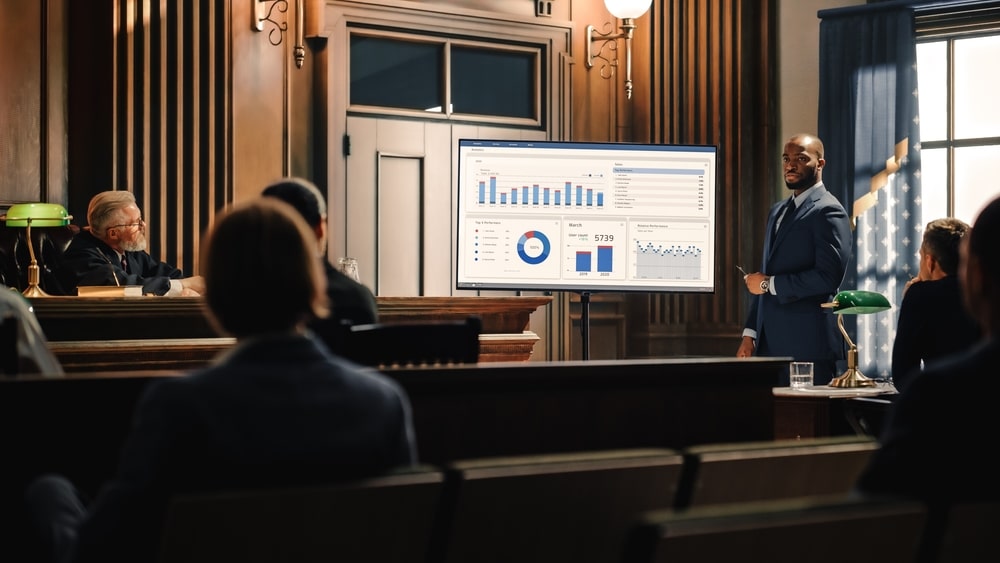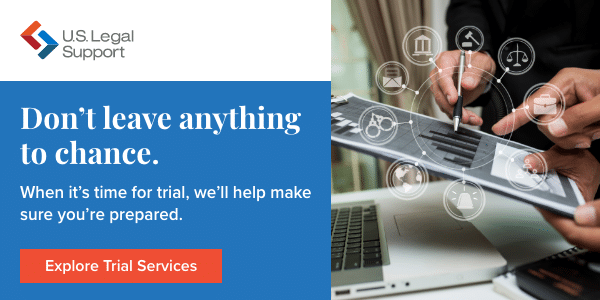Using Trial Demonstratives for Litigation

Is a picture worth a thousand words? In the litigation world, it may be worth thousands of dollars, but only when used as a supplement to words rather than a replacement.
Trial demonstratives—comprising illustrations, pictures, videos, animations, charts, and more—are used to provide the “Oh! I get it!” factor as jurors and judges absorb thousands of spoken words. They can help tell a story, clarify complex information, and improve jurors’ memory of the testimony they illustrate.1
And they aren’t just being used during witness testimony and case arguments. More and more, carefully produced demonstratives are used at the deposition level and integrated into legal briefs and other court submissions.2
Understanding the nature of trial demonstratives and how and when they can be used can help you improve your clients’ chances of successful outcomes at all stages of litigation.
Common Types of Trial Demonstratives Used in Court
While you can showcase demonstrative evidence at trial via handouts or poster-size blowups, the most commonly used formats are often shared on a large display or individual viewing screen. Demonstratives may be a mix of entirely custom content and excerpts, scans, enhancements, and clips of discovered evidence and content, including formats like3:
- Drawings, illustrations, and diagrams
- Charts, graphs, and timelines
- Slide presentations (e.g., PowerPoint)
- Color or black and white photographs, both individual and time-lapse
- X-rays, MRIs, CT scans, medical charts, and other health records
- Paper documents or other printed or written materials
- Video and audio recordings (e.g., depositions, reenactments, tests, demonstrations)
- Animations including medical, scientific, anatomical, and machinery
- Digital models of crime scenes, actions, or products
- 3D models (e.g., anatomical, architectural, product component)
How Trial Demonstratives Support Litigation Strategy
During a trial, jurors are required to actively listen for hours on end. The testimony is often scientific or technical, or may be exploring multiple versions of a series of events and actions that aren’t intrinsically compelling. Witnesses may have little to no public speaking skills and often get interrupted time and again with attorney questions.
All of these factors make trial demonstratives not just helpful but essential. They graphically depict concepts so as to1:
- Present information, especially technical or factual details, in a more interesting way
- Simplify and clarify key facts and issues
- Help the court and jurors retain and recollect evidence
- Increase the persuasiveness of your argument
Studies have shown that, for most people, about 15% of learning occurs from what is heard, while 85% is based on what is seen.3 But it’s not one or the other—the combination of both words and visual content is critical to what is recalled or how an audience perceives the information presented.
For instance, after seeing the same car accident video, individuals asked to estimate the speed at which the cars “hit” each other averaged 30 miles per hour, while those asked about how fast the cars “smash” each other replied with an average of 40 mph.4
Best Practices for Creating Effective Trial Demonstratives
Trial demonstratives are interesting intersections of the law, graphic design, and a particular case story and strategy. When planning demonstratives, you’ll want to consider all of these angles, along with the following best practices.
Keep the Jury’s Attention
Trial demonstratives help jurors absorb and retain information by connecting what they hear to visual imagery or data, and you can affect how triumphant that process is. To make the most of your demonstratives3,5,
- Use formats that build incrementally (e.g., layers, slides) to illustrate points.
- Consider options that allow witnesses to stand up and move around during testimony.
- Write, draw, or annotate information in front of the jury.
- Maximize how long demonstratives remain in view to reinforce their persuasive effect.
- Make the final screen of a moving demonstrative what you want jurors to recall most.
Follow Key Design Principles
Trial-winning demonstratives don’t display the flashiest, prettiest, or most complex designs. At its heart, demonstrative design encourages the simplest solution to best communicate a message. Design principles that are front and center for trial demonstratives include3:
- Simplicity, clarity, and visibility
- High lettering or background contrast and simple, legible fonts
- Color and style choices that best support intentional storytelling, drama, and visibility
- Using the optimal format for the content, message, and audience
- Match the medium and format to the specific environment and technology
Anticipate Attacks
While demonstratives often serve to enhance an emotional response and reinforce your case facts, be hawkish on monitoring accuracy and admissibility while avoiding extraneous information. In addition to nitpicking details related to accuracy, the opposing team can object to demonstratives based on5,6,
- Relevance
- Cumulative evidence and necessity
- Unfair prejudice that outweighs probative value
- Foundation not laid, including authentication
- Hearsay
- Danger of a physical exhibit (e.g., sharp edges, blocking fire exits)
- Undue consumption of time
In addition to objections, you’ll need to protect your demonstratives against being used against you. Rather than trying to get it thrown out, opposing counsel could also mark up, alter, or overlay your demonstrative to “correct” it during their arguments or witness examination.3
One way to help avoid these outcomes (and provide a basis for appeal) is to address demonstratives as a pretrial matter before the court. Request that opposing counsel initiate any discussions or demands related to your demonstratives outside the presence of the jury during the trial.5
Consider Confrontational Demonstratives
While they usually focus on furthering your case theory directly, consider whether it would be useful to use demonstratives aggressively. For instance, focus on the opponent’s case theory and list or illustrate:
- All of the coincidences that would need to occur for it to be true5
- Missing evidence that should realistically have been discovered
- The presence of bias or procedural errors
Allow for Quick Changes
Whether it’s a zig to counter opposing counsel’s zag, a modification in the face of an objection, or a workaround for a technical glitch, make sure your demonstratives can be easily adjusted. This means having access to editable files and securing outsourced partners to make changes in real time.
Design Demonstratives for Deliberation
While you’ll have to work for it, having your demonstrative provided to the jury during deliberation can help your case continue to be heard at this critical phase. Demonstratives aren’t generally allowed to pass through to the jury, so to make this happen, you’ll need to7:
- Ensure the exhibit is self-explanatory without requiring a lawyer to explain it
- Prepare relevant case law to support your request
- Provide it in an easy-to-use format using the lowest tech option
Although your chances are best with exhibits that contain neutrally sourced data, such as a damages chart, there have been multiple cases of courts allowing more into the jury room. In United States v. Downen, a judge’s decision to provide a chart summarizing the government’s case was upheld based on the clarity and caution of his jury instructions.7
Test Your Demonstratives
Finally, include demonstrative testing in your trial preparation. This can include using demonstratives:
- As you develop and rehearse your arguments (i.e., realtime adjustments)
- During witness preparation
- In a mock trial or before a focus group for testing
- Before colleagues to help anticipate objections and admissibility concerns
In addition to refining your demonstratives’ design and polishing their strategic use, you’ll also want to address technical readiness by ensuring:
- Demonstratives are tested on the actual software and hardware to be used
- Final demonstratives are the best fit for the scheduled courtroom environment
- Backups are available
- Physical demonstratives are closely evaluated for safety and ease of setup
Legal Considerations: Admissibility & Rules of Evidence
Trial demonstratives must be consistent with the rules of evidence of the jurisdiction in which they are presented. Per the Federal Rules of Evidence (FRE), demonstrative evidence must adhere to8:
- Relevance – Must be relevant and comply with FRE 107, 401, 402, 611, and 1006
- Unfair prejudice – Probative value is greater than the issues listed in FRE 403
- Hearsay – Cannot be inconsistent with FRE 803 and 804 hearsay exceptions
- Authentication & opinion – Must be consistent with FRE 602, 701, 702, 901, 90210
Enhancing Litigation Outcomes with Demonstratives
Demonstrative evidence at trial—and before cases reach the courtroom—is critical to achieving successful outcomes for your clients. Designing the right types of exhibits is both an art and a science, with a long list of considerations to ensure they meet admissibility standards, aren’t used against you, and achieve your goals.
That means partnering with the right experts. After supporting more than 53,000 high-risk trials, arbitrations, and mediations, our team of experts at TrialQuest can plan and execute trial demonstratives that make a difference for your cases. From still to interactive exhibits, we offer photography, videography, animation, illustration, and 3D modeling.
Plus, we’re a full-service support provider. We can help with jury research and litigation consulting, mock trials, witness preparation, and trial services.
Contact us to discuss how we can help refine and improve the effectiveness of your trial demonstratives and address other support needs.
Sources:
- Leesfield & Partners. Effective Use of Demonstrative Evidence. https://www.leesfield.com/effective-use-of-demonstrative-evidence.html
- HeinOnline. The Power of the Visual: Incorporating Images into Briefs. https://heinonline.org/HOL/LandingPage?handle=hein.journals/usab71&div=11&id=&page=
- National Institute of Justice. Law 101: Legal Guide for the Forensic Expert: Visual and Demonstrative Aids. https://nij.ojp.gov/nij-hosted-online-training-courses/law-101-legal-guide-forensic-expert/importance-case-preparation/visual-and-demonstrative-aids
- Springer Nature. Courting the Visual Image: The Ability of Digital Graphics and Interfaces to Alter the Memory and Behaviour of the Viewer. https://link.springer.com/chapter/10.1007/978-3-319-91238-7_27
- Courtroom Warrior. Effective Use of Demonstrative Exhibits at Trial. https://courtroomwarrior.com/blog/articles_eudet/
- The Florida Bar Journal. No Ideas But in Things: A Practitioner’s Look at Demonstrative Evidence. https://www.floridabar.org/the-florida-bar-journal/no-ideas-but-in-things-a-practitioners-look-at-demonstrative-evidence/
- Trial Tuesdays. Can You Give Demonstratives To The Jury? https://www.trialtuesdays.com/blog/can-you-give-demonstratives-to-the-jury
- Hawkins Parnell & Young LLP, Evidence (Real & Demonstrative). https://www.hpylaw.com/content/uploads/2019/03/216_Evidence-Real-and-Demonstrative.pdf
- Cornell Law School. Rule 901. Authenticating or Identifying Evidence. https://www.law.cornell.edu/rules/fre/rule_901
- Cornell Law School. Rule 902. Evidence That Is Self-Authenticating. https://www.law.cornell.edu/rules/fre/rule_902

Editoral Policy
Content published on the U.S. Legal Support blog is reviewed by professionals in the legal and litigation support services field to help ensure accurate information. The information provided in this blog is for informational purposes only and should not be construed as legal advice for attorneys or clients.


